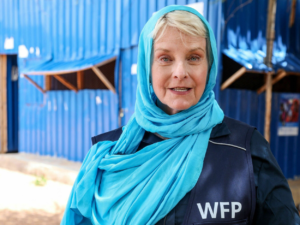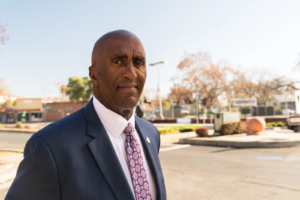For a preview of what a hotter, more geopolitically unstable future might look like, you don’t have to go much further than the world’s shipping lanes—the daily commute for most of our consumer goods, from solar panels to sneakers. Drought exacerbated by climate change in Central America has reduced traffic through the Panama Canal by 40%. Meanwhile, shipping through the Suez Canal, linking Europe to Asia, has come to a near standstill as Iranian-backed Houthi militants in Yemen escalate attacks on Red Sea cargo ships in what they say is a protest against Israel’s military campaign in Gaza.
There are alternatives of course. Shippers with New York-bound goods from Shanghai can dock in Los Angeles and truck their wares across the U.S. instead. And cargo ships plying the Europe-Asia route through the Suez Canal can take the long way around Africa. Those alternatives are often slower—adding up to 15 days on some Europe-Asia routes—and more expensive. But the bigger long-term cost comes in the form of increased planet-warming carbon emissions.
Jacob Armstrong, the shipping policy manager for the Brussels-based sustainable transport advocacy organization Transport & Environment, calculated the extra emissions produced by one such cargo ship, the Al Zubara, which is currently taking the long route from the European port of Rotterdam to China. According to Armstrong, the Al Zubara would normally produce 7,841 metric tons of CO2 going through the Suez Canal. Now diverted around South Africa, it will emit 10,360 metric tons of CO2—an increase that is the equivalentof burning 13.9 rail cars’ worth of coal. (Sequestering that amount of carbon would require 41,652 tree seedlings to grow for 10 years).

Considering that 68 ships transit the Suez Canal per day on average, and that approximately 95% of the traffic is currently being rerouted, that could come to an extra 162,727 metric tons of emissions for every day that the conflict continues (about the same amount that a natural-gas fired power plant emits over five months). “Disruption to global trade does tend to mean more emissions. So yeah, so this is really bad for the climate,” says Armstrong.
Unlike the Suez Canal, which links two bodies of water at similar elevations, transit through the Panama Canal relies on a series of ascending locks that use water drawn from a nearby lake. But several seasons of little-to-no rainfall have lowered the water levels, and as a result boats passing through the canal have had to reduce their cargo loads by 40% in order to reduce draft. That translates into diversions, delays, and additional CO2 emissions, especially if shippers turn instead to diesel powered trains and trucks to transport goods over land.
Compared to other major sources of emissions, the overall climate impact of choked global shipping traffic is marginal, says Armstrong. But if global demand for goods increases cargo ships will be tempted to lay on the gas, increasing emissions exponentially, says Armstrong. “Shipping speed, not distance, is actually the biggest threat for climate impacts.
Armstrong calculates that if shipping companies reduced their speed by 10%, total emissions for the shipping sector would be cut by 30%—a significant improvement for an industry responsible for 2% of global emissions. Even when additional journeys are factored in to make up for slower turnaround times, the end result is a 19% reduction in emissions. “There are a lot of simple things that can be done to reduce shipping’s climate impact,” says Armstrong. “Slowing down is the simplest.”
If anything, the bottlenecks in the two canals proves that the industry is resilient. While shipping fees have gone up, economies of scale mean that prices on the transported goods themselves have not. Long term, that may change. But short term, it demonstrates that ships can take several days longer with little impact on the end consumer. That also means they can probably slow down once the Suez Canal opens up again, with a much better impact on the climate.




